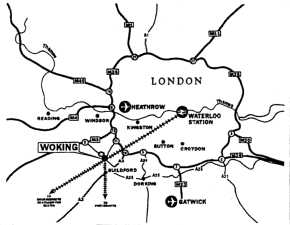HRA - Around Horsell Village
A Short History of Horsell
 The meaning of the name Horsell presents quite a problem, as it is not recorded in
documents until the 13th century. It probably derives from "Horig Scylf", meaning a muddy
slope or shelf on a hill - presumably relating to the wetlands around the village site.
The meaning of the name Horsell presents quite a problem, as it is not recorded in
documents until the 13th century. It probably derives from "Horig Scylf", meaning a muddy
slope or shelf on a hill - presumably relating to the wetlands around the village site.
Although Horsell has been inhabited for thousands of years it is only in historically modern
times that it has had a population numbering thousands rather than hundreds. During most of
the 19th century the village was a single street of cottages, farms and workshops, surrounded
by fields, heathlands and nurseries. Despite its proximity to Woking (which began to develop
rapidly from the 1860's around Woking Common Station, initially opened in 1838 on heathland),
Horsell remained entirely rural in character.
ZOOM IN/OUT:
From first edition of the one-inch Ordnance Survey of England & Wales, electrotyped 1862.

ZOOM IN/OUT: From first edition of the one-inch Ordnance Survey of England & Wales,
electrotyped 1862.

 At the eastern summit of the village street was the ancient church of St.Mary the Virgin, and
at the southern foot of the hill was the village brewery beside
Horsell Moor. At the other western edge, the village petered out into
a string of squatter dwellings which fronted the common at Horsell Birch. To the north and east,
Horsell Common originally formed part of the Manor of Pyrford (owned by the Earl of Onslow)
and local inhabitants had certain grazing rights, but land ownership in the village itself
was unusually fragmented, and what began as several small farms and market gardens has resulted
in an uncoordinated development. Each piece of land was separately sold and built over later,
each with its own access road, which accounts for the complex road pattern west of Horsell High
Street. In 1801 the village had about 250 inhabitants, with 443 in the parish as a whole.
At the eastern summit of the village street was the ancient church of St.Mary the Virgin, and
at the southern foot of the hill was the village brewery beside
Horsell Moor. At the other western edge, the village petered out into
a string of squatter dwellings which fronted the common at Horsell Birch. To the north and east,
Horsell Common originally formed part of the Manor of Pyrford (owned by the Earl of Onslow)
and local inhabitants had certain grazing rights, but land ownership in the village itself
was unusually fragmented, and what began as several small farms and market gardens has resulted
in an uncoordinated development. Each piece of land was separately sold and built over later,
each with its own access road, which accounts for the complex road pattern west of Horsell High
Street. In 1801 the village had about 250 inhabitants, with 443 in the parish as a whole.
It was only from the 1880's onwards that the parish came increasingly within the suburbanising
influence of Woking's expansion, and developed into the village that stands today.
Suburban development began around Woking railway station in the late 1860s but did not extend
to Horsell until the 1880s. The force behind the growth of Horsell was the tremendous
improvement in transport that followed the Industrial Revolution of the 18th century. By the
end of the 19th century, railways had superseded horsedrawn vehicles for long journeys and
bicycles were a popular means of local transport.
Thus Horsell was still very much a country village when in 1895 it was incorporated into the
newly formed Woking Urban District. At that time it was a rural community of farmers and
nurserymen, with several inns, a brewery, a smithy, a post office and a variety of supporting
tradesmen, craftsmen and labourers. Also scattered around the parish were
several gentlemen's houses, a vicarage, at least two chapels incorporating living quarters
for their ministers and an assortment of terraced and semi-detached houses.
Since then, most of the farms and nurseries have been sold and separately developed. The
resulting slow, sporadic growth has allowed the occupiers of the new shops and houses to
absorb the atmosphere of the village, and enabled the village to retain its individuality.
And today, the character of Horsell and some of its remaining old buildings can still give
visitors an indication of what it was like to live there in times past. Take a heritage walk
around the southern part or the western end
of the village and discover more.
Information based on leaflets written by Horsell Residents' Association.
All details in the leaflets believed to be correct at the original time of printing (July 1996).
The leaflets are part of a series of self-guided walks. They are available free at the
Civic Offices, at Woking Visitor Information Centre and at Woking Library

How to get there:
Bus Services:
Call the Transport Information Bureau on 01483 750525
Train Services:
Call 0171 928 5100 for information